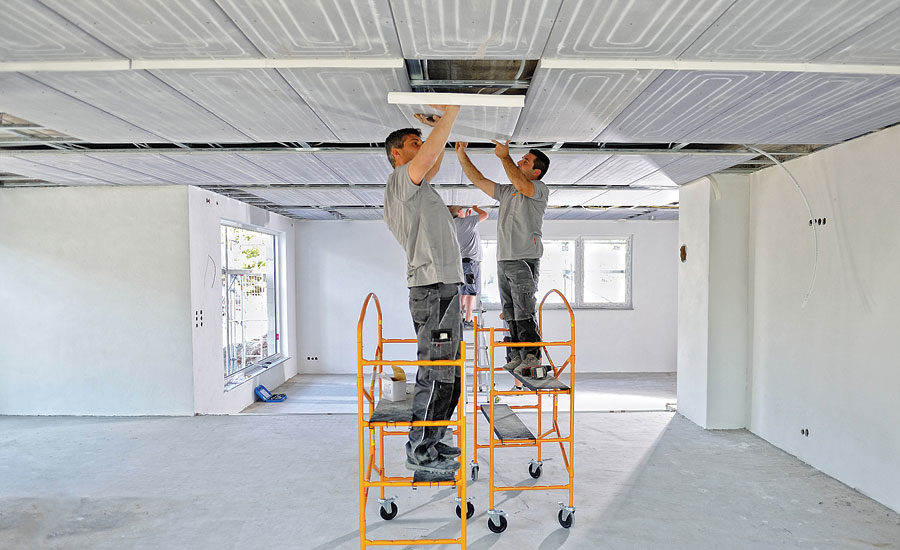Hydronic radiant ceiling panel offer an innovative and efficient way to heat your home or commercial space. By leveraging the principles of radiant heating, these panels can provide consistent, comfortable warmth while improving energy efficiency. This comprehensive guide will explore the benefits, installation process, and maintenance of hydronic radiant ceiling panels, ensuring you have all the information needed to make an informed decision.

What are Hydronic Radiant Ceiling Panels?
Understanding Hydronic Radiant Heating
Hydronic radiant heating involves circulating hot water through pipes embedded in panels, floors, or walls. These systems radiate heat directly to objects and people in the room, creating a comfortable and consistent temperature without the need for forced air.
Components of Hydronic Radiant Ceiling Panels
- Radiant Panels: These panels contain tubing or pipes through which heated water flows.
- Heat Source: Typically, a boiler or water heater that supplies hot water to the system.
- Piping: Connects the heat source to the radiant panels.
- Thermostats and Controls: Regulate the temperature and operation of the system.
Read too: Striped Schoolhouse Ceiling Light Fixtures: Unveiling the Timeless Charm
Benefits of Hydronic Radiant Ceiling Panels
Energy Efficiency
Hydronic radiant ceiling panels are highly efficient as they directly heat objects and people rather than the air. This direct method of heating reduces energy loss and can lower heating costs.
Enhanced Comfort
The heat radiated from ceiling panels is evenly distributed, eliminating cold spots and drafts. This creates a more comfortable living or working environment.
Quiet Operation
Unlike forced-air systems, hydronic radiant heating operates silently, making it ideal for noise-sensitive areas such as bedrooms and offices.
Space-Saving
Ceiling panels are unobtrusive and save valuable floor and wall space, allowing for more flexible interior design.
Improved Air Quality
Hydronic radiant systems do not circulate dust, allergens, or other airborne particles, improving indoor air quality and reducing the risk of respiratory issues.
How Hydronic Radiant Ceiling Panels Work
Heating Process
- Heat Generation: A boiler or water heater heats water to a predetermined temperature.
- Water Circulation: The heated water is pumped through a network of pipes connected to the ceiling panels.
- Radiant Heat Emission: The panels radiate heat downward into the room, warming objects and people.
- Thermostatic Control: Thermostats monitor and adjust the water temperature to maintain the desired room temperature.
Types of Hydronic Radiant Ceiling Panels
Metal Panels
Metal panels, often made of aluminum or copper, have high thermal conductivity and are highly efficient at transferring heat. They are durable and provide quick heat-up times.
Gypsum Panels
Gypsum panels integrate radiant tubing within gypsum board, which can be finished to match standard drywall. These panels offer a more integrated and aesthetically pleasing appearance.
Installation of Hydronic Radiant Ceiling Panels
Planning and Design
- Heat Load Calculation: Determine the heating requirements of the space to ensure the system can provide adequate warmth.
- Panel Placement: Strategically place panels to ensure even heat distribution.
- System Layout: Design the piping layout to minimize heat loss and ensure efficient water circulation.
Tools and Materials Needed
- Hydronic radiant ceiling panels
- Boiler or water heater
- Piping and fittings
- Thermostats and control systems
- Insulation materials
- Fasteners and mounting hardware
Step-by-Step Installation
Step 1: Prepare the Ceiling
Ensure the ceiling surface is clean, dry, and free from any obstructions. Install any necessary support structures for the panels.
Step 2: Install Piping
Lay out the piping according to the design plan, ensuring proper spacing and secure attachment to the ceiling joists or other support structures.
Step 3: Mount the Panels
Securely attach the hydronic radiant ceiling panels to the ceiling, ensuring they are level and properly aligned with the piping.
Step 4: Connect the System
Connect the piping to the boiler or water heater and install the thermostats and control systems. Ensure all connections are secure and leak-free.
Step 5: Insulate
Apply insulation around the piping and panels to minimize heat loss and improve system efficiency.
Step 6: Test the System
Fill the system with water and pressurize it to check for leaks. Once all connections are secure, start the system and monitor its performance to ensure it operates correctly.
Maintenance of Hydronic Radiant Ceiling Panels
Regular Inspections
Periodically inspect the system for leaks, corrosion, or damage. Check the boiler or water heater, piping, and panels for any signs of wear or malfunction.
Cleaning
Keep the ceiling panels clean to ensure efficient heat transfer. Dust and debris can reduce the system’s effectiveness.
System Flushing
Flush the system periodically to remove any sediment or buildup that could impede water flow and reduce efficiency.
Thermostat Calibration
Ensure thermostats are properly calibrated to maintain the desired room temperature and optimize energy usage.
Frequently Asked Questions
Are Hydronic Radiant Ceiling Panel Suitable for All Climates?
Hydronic radiant ceiling panels can be used in various climates but are particularly effective in colder regions where consistent heating is necessary.
How Long Do Hydronic Radiant Ceiling Panels Last?
With proper maintenance, hydronic radiant ceiling panels can last for several decades, making them a durable and long-lasting heating solution.
Can Hydronic Radiant Ceiling Panels Be Used with Renewable Energy Sources?
Yes, hydronic radiant systems can be integrated with renewable energy sources such as solar water heaters, enhancing their environmental benefits and reducing reliance on fossil fuels.
Are Hydronic Radiant Ceiling Panels Easy to Retrofit?
Retrofitting hydronic radiant ceiling panels into an existing building can be challenging and may require significant modifications. However, they are easier to install in new construction projects.
Conclusion
Hydronic radiant ceiling panel offer a highly efficient and comfortable heating solution for both residential and commercial spaces. By understanding their benefits, installation process, and maintenance requirements, you can make an informed decision about integrating this innovative heating technology into your space. Whether you seek improved energy efficiency, enhanced comfort, or better air quality, hydronic radiant ceiling panels are a smart investment for the future of indoor heating.